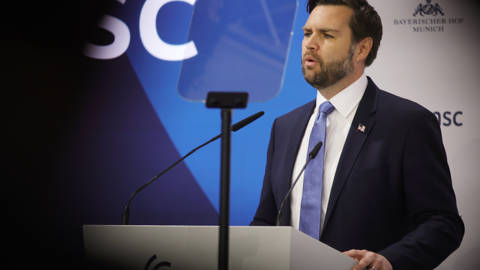OnPoint Subscriber Exclusive

Mordecai Kurz
Says More…
This week in Say More, PS talks with Mordecai Kurz, Joan Kenney Emeritus Professor of Economics at Stanford University.
Project Syndicate: “Contrary to the longstanding conventional wisdom,” you wrote last year, “the monopoly power conferred by new technologies” is not short-lived, nor is it a “small price to pay for the associated benefits.” Not only does excessive market power pose a threat to democracy; you explain in your book, The Market Power of Technology: Understanding the Second Gilded Age, that it also impedes the diffusion of innovations, as your General Electric case study shows. What strategies did GE use to slow the diffusion of electricity, and how similar are they to those of today’s digital-technology firms?
Mordecai Kurz: GE’s tactics were very similar to those of contemporary firms. First, it used a patent strategy to prolong the period over which all its technologies for producing electricity were protected from competition. For example, it patented every component of the light bulb – the glass, casing, etc. – and virtually all equipment used in the production of its lamps. With this “patent pyramid,” it preserved its market power long after the key patent for Thomas Edison’s carbon filament bulb expired in 1897.
GE’s invention of the modern tungsten filament in 1909 consolidated its monopoly in light bulbs. GE also redesigned a large number of new products (many of which it did not invent) – from electric toasters to flexible X-ray machines and, later, home appliances, industrial equipment, radio and television networks, magnetic resonance imaging (MRI) scanners, and jet engines – and marketed them under patent protection.
The other key strategy focused on acquisitions. After losing the “battle of the currents” to Westinghouse, which owned the superior alternating-current patent, in 1896, the two companies signed a patent-sharing agreement, which enabled them jointly to monopolize electric equipment for almost a century. In 1901, GE created the National Electric Lamp Association, a cartel of small producers licensed to use GE technologies, the prices of which GE controlled. GE also acquired unregulated new public utilities that purchased its generation equipment, though this sweet arrangement changed after 1907 when states began to regulate electric utilities. In 1925, GE participated in an international Phoebus cartel that controlled the manufacture and pricing of incandescent light bulbs until 1939, when it was suspended due to World War II.
GE faced an antitrust suit over the National Electric Lamp Association, but it claimed in court that its patent allowed it. The suit ended in a settlement in 1912, with the Justice Department demanding that GE acquire all the producers – a move that further increased GE’s market power.
A suit was also filed over the GE-Westinghouse pact, but in 1925, the Supreme Court ruled in the corporations’ favor, because antitrust law treats monopoly power granted to innovators as generated spontaneously and, therefore, “innocent.” The case shows that current antitrust laws fail at a fundamental level: while they prohibit cooperation aimed directly at fixing market prices, it is legal to pursue technological cooperation, the real aim of which is creating a monopoly to fix prices.
This helps to explain why, today, most small artificial intelligence firms already cooperate – rather than compete – with the “big boys.” DeepMind, one of the first significant AI firms, was acquired by Google; OpenAI received $13 billion in investment from Microsoft; Anthropic received $4 billion in investment from Amazon and $2 billion from Google; and Inflection AI established a partnership with Microsoft, which calls for the provision of $650 million in licensing fees from the tech giant to the smaller firm.

Winter Sale: Save 40% on a new PS subscription
At a time of escalating global turmoil, there is an urgent need for incisive, informed analysis of the issues and questions driving the news – just what PS has always provided.
Subscribe to Digital or Digital Plus now to secure your discount.
PS: You have called for a “return to the original goal of antitrust policy, which is to restrain the power of businesses,” and for antitrust legislation to be expanded to prohibit “many of the strategies firms use to consolidate and expand their market power.” But, as you note in your book, to “destroy all market power” would substantially weaken the incentive to innovate. How can governments determine how much market power is too much, and how concerned should we be about a regulatory “arms race,” with firms devising new strategies for expanding market power as existing ones are prohibited?
MK: The law needs, first, to recognize explicitly that market power based on technology ownership is the same as any other market power; it is not innocent. Since we must compensate innovators, the question then becomes how much we should pay for their technologies. Fortunately, the answer is already provided by patent law, based on historical experience and reflecting society’s preferences. My proposed approach would preserve patent law but make it more difficult to abuse and thus more effective.
When ten firms use ten patents to establish ownership over their innovations, market power rises, but it is dispersed among these ten firms, which market different products that may be complementary or compete with one another. If a firm increases its market power further organically, by continuing to produce new innovations, that market power should be allowed to stand.
But, as the GE case study shows, aggregate market power can continue to rise even without any new innovations, in at least two ways: if one of the firms uses a patent-manipulation strategy to prolong its monopoly or if one firm acquires some or all of its peers’ technologies. So, to ensure that market power does not grow beyond the level set by patent law, there must be rules against patent pyramids and other strategies that abuse patent law, mergers and acquisitions involving related technologies, and business practices that suppress other firms’ activities.
On patents, the key problem is the issuing of large numbers of trivial patents and of multiple interrelated patents (patent pyramids) – practices that researchers agree amount to abuses of the system. To address this, I propose increasing the quality standards for patents and distinguishing between “primary” patents for novel innovations and “secondary” patents, the definition of which relies on a primary patent. Secondary patents should last only half as long as primary patents. Stricter rules governing the acquisition of patents directly or through mergers are also needed.
Technological empires created by acquisitions amount to an even bigger problem. Between 1987 and 2020, five giant firms – Microsoft, Facebook, Salesforce, Google, and Amazon – acquired 721 firms. My proposed policy, which would prohibit acquisitions by firms above a certain size that combine related technologies, would have prevented most of them, because acquisitions of related technologies have the same market-concentration effect as the acquisition of firms selling related products. In my book, I propose several criteria for assessing the complementary nature of technologies involved in proposed acquisitions. Ultimately, we must think of technological control in the same way we think of product-market concentration.
As for a spiraling “arms race,” with firms constantly devising new ways of suppressing competition, I do not see great cause for concern. What is needed is to convince the courts that these tech-company acquisitions should be subject to antitrust enforcement. From 1954 to 1980, antitrust worked reasonably well in preventing practices used to restrain trade. But the “Chicago antitrust project” – Chicago School economists’ approach to competition – convinced the courts effectively to abandon antitrust. The good news is that some tech-company acquisitions have recently attracted antitrust action by the US Justice Department.
To track the effectiveness of antitrust policies, governments must begin recording data on market power—measured by the share of monopoly profits or other markup measures—by industry grouping. I have done this for the total economy from 1889 to 2017, and it can be done using any one of the methods cited in Chapter 4 of my book.
PS: Even if national policymakers use their authority to redirect the evolution of market power, digital markets are not confined by political borders. How does this complicate efforts to restrain tech firms’ market power, and is there a place for, say, a global patent regime?
MK: Countries and firms have different interests. Rising market power in France or India exploits the workers, owners of capital, and consumers in those countries and has wide-ranging negative effects on their domestic economies. That market power affects, say, Americans mainly via its primary effect on the prices of the goods and services these countries trade with the United States; secondary effects in the US would be small. Given this, it appears to me that the costs of building a fully coordinated international policy might be too high compared with the relatively small gains it would bring. If each country contains market power at home, it would be enough to reduce market power globally.
I agree, however, that when large firms operate internationally, diverse digital restrictions will require them to adjust to the restrictions of each country when they would probably prefer uniformity. Firms’ desire for consistent market rules cannot be squared fully or forcefully with the diversity of cultures and mindsets, but I do believe that, over time, national regulations will converge.
BY THE WAY . . .
PS: You note in The Market Power of Technology that implementing the policy agenda you recommend in the United States would run up against significant constitutional challenges. What is the biggest barrier to progress?
MK: The most significant force resisting reform is the US Supreme Court. It has always acted as if the free-market competitive model is embedded in the US Constitution. Many rulings –notably, the Lochner decision of 1906 and the Citizens United decision of 2010 – reflect this political ideology.
Since the 1980s, the Court has fully embraced the Chicago School view that antitrust was intended to maximize consumer welfare by ensuring consumers pay the lowest current price. This simplistic take on antitrust completely ignores all of the dynamic strategies firms use to gain and consolidate market power, including mergers, business concentration, acquisition of competitors, vertical integration, and predatory pricing. So, while these are standard topics of antitrust litigation, the Supreme Court generally dismisses them, thereby effectively suspending antitrust enforcement.
The Chicago School also advanced the idea that technological competition creates timid progressive monopolies that benefit consumers. This is entirely false, as I demonstrated in a past PS commentary, yet a generation of jurists and lawyers were convinced. This belief is reflected, for example, in the late Supreme Court Justice Anthony Scalia’s 2004 opinion in Verizon Communication, Inc. v. Law Offices of Curtis V. Trinko, LLP. “The mere possession of monopoly power, and the concomitant charging of monopoly prices, is not only not unlawful,” he writes, “it is an important element of the free-market system.” The “possession of monopoly power,” he continues, should be found unlawful only if it is “accompanied by an element of anticompetitive conduct.”
Scalia’s opinion is built on the idea that the market is a natural-selection mechanism that enables the strong and efficient to survive. If a monopolist triumphs, it is axiomatically the organization best equipped to offer consumers low prices. This monopolist is not an aggressive exploiter, by this logic; it is a timid firm under constant threat of being replaced by competitors, so it has a strong incentive to keep its prices low. How could a distinguished jurist accept such obviously flawed reasoning?
PS: The overarching goal of the proposals you advance in your book is to mitigate economic inequality. How does limiting market power achieve that?
MK: Lower market power has been shown to reduce inequality directly by increasing wages and compensation to owners of capital while reducing the monopoly profits of technology owners. Simply put, it shifts income from Silicon Valley to Main Street.
This results in other improvements: a higher level of investment (which boosts GNP), less suppression of new innovations (which results in more innovations and more product diversity), faster diffusion of innovations, and a higher economic growth rate. Higher GNP also has secondary effects, raising labor and capital incomes and increasing consumption. All this contributes to a more egalitarian distribution of income, because total labor income and the aggregate capital incomes of retirees and owners of life insurance are distributed much more equitably among individual income recipients than the highly concentrated technology-based monopoly profits.
PS: In your book, you explain that “the tax and investment policies used to transition to a more equitable distribution may not be the policies needed to maintain it.” Which policies must be permanent, and which are transitory?
MK: My book includes a plan to improve the health and education of children of families in the bottom half of the income distribution in the US. To finance it, I propose a short-term wealth tax, lasting just five years. I do not support long-term wealth taxation, because it is difficult to enforce and raises other issues (discussed in my book). But it can be successfully used as a short-term redistributive device. All of the other policies I discuss in the book – relating to antitrust, patent law, the labor market, mergers and acquisitions, and personal and corporate income taxation – would be permanent.



